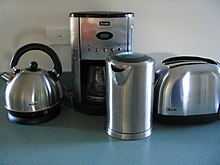
Back Electrodomestico AN جهاز منزلي Arabic جهاز منزلى ARZ Electrodomésticu AST Məişət texnikası Azerbaijani Бытавая тэхніка Byelorussian Битова техника Bulgarian Electrodomèstic Catalan Domácí spotřebič Czech Hårde hvidevarer Danish
| Home appliance | |
|---|---|
 Home appliances may be used in kitchens | |
| Industry | Food and beverages, health care |
| Application | Kitchens and laundry rooms |
| Wheels | In some cases |
| Examples | Refrigerator, toaster, kettle, microwave, blender |
A home appliance, also referred to as a domestic appliance, an electric appliance or a household appliance,[1] is a machine which assists in household functions[2] such as cooking, cleaning and food preservation.
The domestic application attached to home appliance is tied to the definition of appliance as "an instrument or device designed for a particular use or function".[3] Collins English Dictionary defines "home appliance" as: "devices or machines, usually electrical, that are in your home and which you use to do jobs such as cleaning or cooking".[4] The broad usage allows for nearly any device intended for domestic use to be a home appliance, including consumer electronics as well as stoves,[5] refrigerators, toasters[5] and air conditioners.
The development of self-contained electric and gas-powered appliances, an American innovation, emerged in the early 20th century. This evolution is linked to the decline of full-time domestic servants and desire to reduce household chores, allowing for more leisure time. Early appliances included washing machines, water heaters, refrigerators, and sewing machines. The industry saw significant growth post-World War II, with the introduction of dishwashers and clothes dryers. By the 1980s, the appliance industry was booming, leading to mergers and antitrust legislation. The US National Appliance Energy Conservation Act of 1987 mandated a 25% reduction in energy consumption every five years. By the 1990s, five companies dominated over 90% of the market.
Major appliances, often called white goods, include items like refrigerators and washing machines, while small appliances encompass items such as toasters and coffee makers.[6] Product design shifted in the 1960s, embracing new materials and colors. Consumer electronics, often referred to as brown goods, include items like TVs and computers.[7] There is a growing trend towards home automation and internet-connected appliances. Recycling of home appliances involves dismantling and recovering materials.
- ^ "Household Appliance". Lexico Dictionaries | English. Archived from the original on 1 August 2020. Retrieved 25 April 2020.
- ^ Cite error: The named reference
MWwas invoked but never defined (see the help page). - ^ "Appliance". Merriam Webster. Retrieved 24 July 2013.
- ^ "Definition of household appliances". Collins Dictionary. Retrieved 24 July 2013.
- ^ a b Cite error: The named reference
Bulletin 2014was invoked but never defined (see the help page). - ^ "white goods". Collins English Dictionary. Retrieved 5 December 2014.
- ^ "brown goods". Collins English Dictionary. Retrieved 5 December 2014.
© MMXXIII Rich X Search. We shall prevail. All rights reserved. Rich X Search